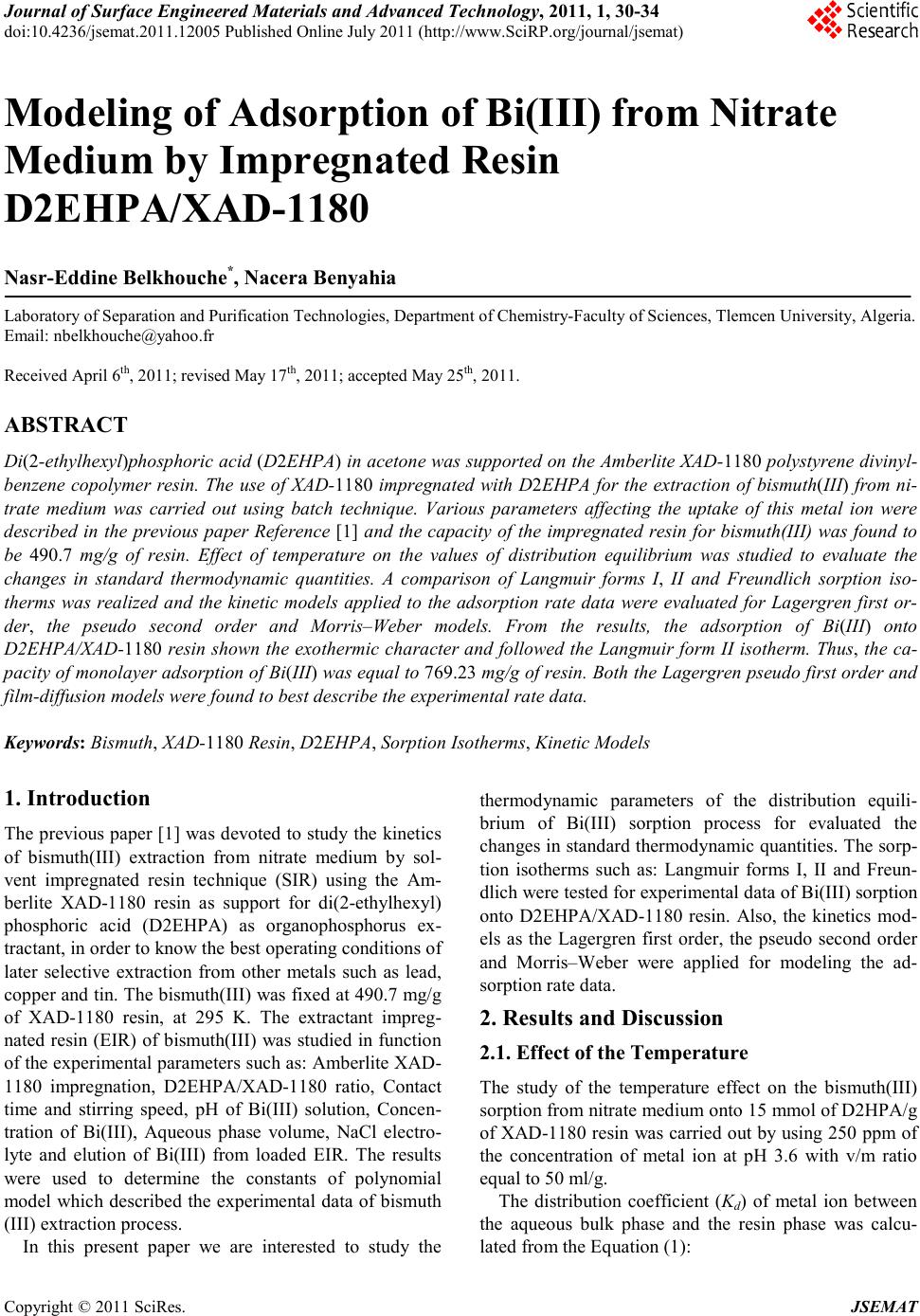
Journal of Surface Engineered Materials and Advanced Technology, 2011, 1, 30-34
doi:10.4236/jsemat.2011.12005 Published Online July 2011 (http://www.SciRP.org/journal/jsemat)
Copyright © 2011 SciRes. JSEMAT
Modeling of Adsorptio n of Bi(III) from Nitrate
Medium by Impregnated Resin
D2EHPA/XAD-1180
Nasr-Eddine Belkhouche*, Nacera Benyahia
Laboratory of Separation and Purification Technologies, Department of Chemistry-Facult y of Sciences, Tlemcen University, Algeria.
Email: nbelkhouche@yahoo.fr
Received April 6th, 2011; revised May 17th, 2011; accepted May 25th, 2011.
ABSTRACT
Di(2-ethylhexyl)phosphoric acid (D2EHPA) in acetone was supported on the Amberlite XAD-1180 polystyrene divinyl-
benzene copolymer resin. The use of XAD-1180 impregnated with D2EHPA for the extraction of bismuth(III) from ni-
trate medium was carried out using batch technique. Various parameters affecting the uptake of this metal ion were
described in the previous paper Reference [1] and the capacity of the impregnated resin for bismuth(III) was found to
be 490.7 mg/g of resin. Effect of temperature on the values of distribution equilibrium was studied to evaluate the
changes in standard thermodynamic quantities. A comparison of Langmuir forms I, II and Freundlich sorption iso-
therms was realized and the kinetic models applied to the adsorption rate data were evaluated for Lagergren first or-
der, the pseudo second order and Morris–Weber models. From the results, the adsorption of Bi(III) onto
D2EHPA/XAD-1180 resin shown the exothermic character and followed the Langmuir form II isotherm. Thus, the ca-
pacity of monolayer adsorption of Bi(III) was equal to 769.23 mg/g of resin. Both the Lagergren pseudo first order and
film-diffusion models were found to best describe the experimental rate data.
Keywords: Bismuth , XAD-1180 Resin, D2EHPA, Sorption Isotherms, Kinetic Models
1. Introduction
The previous paper [1] was devoted to study the kinetics
of bismuth(III) extraction from nitrate medium by sol-
vent impregnated resin technique (SIR) using the Am-
berlite XAD-1180 resin as support for di(2-ethylhexyl)
phosphoric acid (D2EHPA) as organophosphorus ex-
tractant, in order to know the best operating conditions of
later selective extraction from other metals such as lead,
copper and tin. The bismuth(III) was fixed at 490.7 mg/g
of XAD-1180 resin, at 295 K. The extractant impreg-
nated resin (EIR) of bismuth(III) was studied in function
of the experimental parameters such as: Amberlite XAD-
1180 impregnation, D2EHPA/XAD-1180 ratio, Contact
time and stirring speed, pH of Bi(III) solution, Concen-
tration of Bi(III), Aqueous phase volume, NaCl electro-
lyte and elution of Bi(III) from loaded EIR. The results
were used to determine the constants of polynomial
model which described the experimental data of bismuth
(III) extraction process.
In this present paper we are interested to study the
thermodynamic parameters of the distribution equili-
brium of Bi(III) sorption process for evaluated the
chan ges in sta ndard ther modyna mic quantities. The sor p-
tion isotherms such as: Langmuir forms I, II and Freun-
dlich were tested for exp eri mental data o f Bi(III ) sorptio n
onto D2EHPA/XAD-1180 resin. Also, the kinetics mod-
els as the Lagergren first order, the pseudo second order
and Morris–Weber were applied for modeling the ad-
sorptio n ra te data.
2. Results and Discussion
2.1. Effect of the Temperat ure
The study of the temperature effect on the bismuth(III)
sorptio n from nitrate mediu m onto 15 mmol of D2HPA/g
of X AD-1180 resin was carried out by using 250 ppm of
the concentration of metal ion at pH 3.6 with v/m ratio
equal to 50 ml/g.
The distribution coefficient (Kd) of metal ion between
the aqueous bulk phase and the resin phase was calcu-
lated from the Equation (1):